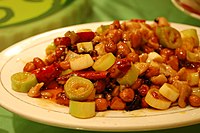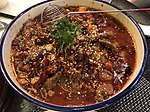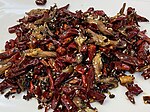Loading AI tools
Cuisine originating from the Sichuan province of China From Wikipedia, the free encyclopedia
Sichuan cuisine or Sichuanese cuisine, alternatively romanized as Szechwan cuisine or Szechuan cuisine (Chinese: , Standard Mandarin pronunciation: [sɨ̂.ʈʂʰwán] )[1] is a style of Chinese cuisine originating from Sichuan province and the neighboring Chongqing municipality. Chongqing was formerly a part of Sichuan until 1997; thus, there is a great deal of cultural overlap between the two administrative divisions. There are many regional, local variations of Sichuanese cuisine within Sichuan and Chongqing.[2]
| Sichuan cuisine | |||||||
|---|---|---|---|---|---|---|---|
 | |||||||
| Chinese | 四川菜 | ||||||
| |||||||
| Chuan cuisine | |||||||
| Chinese | 川菜 | ||||||
| |||||||

It has bold flavours, particularly the pungency and spiciness resulting from liberal use of garlic and chili peppers, as well as the unique flavour of Sichuan pepper. Some examples are Kung Pao chicken and Yuxiang shredded pork. Four sub-styles of Sichuan cuisine include Chongqing, Chengdu, Zigong (known for a genre of dishes called Yanbangcai), and Buddhist vegetarian style.[3]
UNESCO declared Chengdu, the capital of Sichuan Province, to be a city of gastronomy in 2011 to recognise the sophistication of its cooking.[4]
In the Middle Ages, Sichuan welcomed Middle Eastern crops, such as broad beans, sesame and walnuts. Since the 16th century, the list of major crops in Sichuan has even been lengthened by New World newcomers. The characteristic chili pepper originally came from Mexico but probably overland from India or by river from Macau, complementing the traditional Sichuan peppercorn (花椒; huājiāo). Other newcomers from the New World included maize (corn), which largely replaced millet; white potatoes introduced by Catholic missions; and sweet potatoes. The population of Sichuan was cut by perhaps three-quarters in the wars from the Ming dynasty to the Qing dynasty. Settlers from the adjacent Hunan Province brought their cooking styles with them.[5]
Sichuan is colloquially known as the "heavenly country" due to its abundance of food and natural resources. One ancient Chinese account declared that the "people of Sichuan uphold good flavour, and they are fond of hot and spicy taste." Most Sichuan dishes are spicy, although a typical meal includes non-spicy dishes to cool the palate. Sichuan cuisine is composed of seven basic flavours: sweet, sour, numbing-spicy (like in Sichuan pepper), spicy, bitter, fragrant/aromatic, and salty. Sichuan food is divided into five different types: sumptuous banquet, ordinary banquet, popularised food, household-style food and snacks. Milder versions of Sichuan dishes remain a staple of American Chinese cuisine.[6][7]
The superior natural resources of Sichuan Province provided plenty natural resources for the development of cooking. The flow of the Yangtze river through Sichuan Province provided nutrients for fundamental foods, spices, and a source of water.[8]
This section may need to be rewritten to comply with Wikipedia's quality standards. (June 2024) |
Reconstructing the theoretical system of modern Sichuan cuisine under the new normal, including the division of the three schools of Sichuan cuisine, On the basis of the established theory of Shanghe Bang, Xiaohe Bang and Xiahe Bang, the standardized and complete expression is:
Shanghe Gang Sichuan cuisine is Rongpai Sichuan cuisine in Chengdu, Leshan-centered areas in the west of Sichuan. Its characteristics are friendly and peaceful, rich in seasoning, relatively light taste, multi-traditional dishes;[9] Using chilli bean paste and sugar to flavor, it is the most widely circulated Sichuan cuisine. Shanghe Bangchuan cuisine is based on traditional classical recipes. It has a mild taste and a long flavor. At the same time, it concentrates on high-end government dishes such as royal and official dishes. Delicate and delicate, most of them are traditional Sichuan cuisine that has been handed down for a long time, and it has always been the official cuisine of Sichuan Governor and General Yamen. The overall taste of Shanghe Bang cuisine is mild. Hot pot is mainly oil-clearing hot pot and shuttle edge fish hot pot.[10][11]
Xiaohe Bangchuan cuisine is salt gang cuisine centered on Zigong in southern Sichuan, including Yibin cuisine, Luzhou cuisine and Neijiang cuisine, which are characterized by thick taste, heavy taste and rich taste. Characterized by atmospheric, weird, high-end (the reason is salt merchants). Zigong Yanbang dishes are divided into three branches: salt commercial dishes, salt industrial dishes and hall dishes, with spicy taste, Mala taste and sweet and sour taste as three main categories.[12] Yanbang dishes are characterized by rich, distinctive and rich taste. The most important thing to pay attention to is the taste of the food.[13]
Xiahe Bangchuan cuisine is represented by Dazhou cuisine, Chongqing cuisine and Wanzhou cuisine. Together, they form the three main local flavor schools of Sichuan cuisine, representing the highest artistic level of Sichuan cuisine development.[14]
Therefore, Sichuan cuisine has three characteristics: extensive ingredients, diversified flavoring, and strong adaptability to cuisine. It consists of five major categories: banquet dishes, popular side dishes, home-cooked dishes, SanZhengJiuKou dishes,[15] flavor snacks and so on to form a complete flavor system.[16]
There are also some different theories about the division of Sichuan cuisine regions, Wang Dayu introduced in the compilation of Sichuan cuisine history strategy by the Committee on Literature and History of the CPPCC in the whole country: Sichuan cuisine can be roughly divided into Chengdu Bang, Chongqing Bang, Dahe Bang, Xiaohe Bang, from the inside, each has its own special background and representative menu.[17] Sichuan cuisine originated in Shu during the Spring and Autumn period and the Warring States period, the beginning of Qin and Han dynasties, and the formation of classical Sichuan cuisine in Han and Jin dynasties. Characterized by Sichuan peppercorn and ginger. In the Tang and Song Dynasties, Sichuan cuisine was developed further, and Sichuan restaurants spread throughout Kaifeng and Lin'an, and won the favor of many diners for their taste characteristics. During the Song dynasty, Sichuan cuisine became an independent cuisine.
Sichuan is rich in products, and natural crops provide abundant raw materials for Sichuan cuisine. Among them, ginger, Sichuan pepper and other seasonings, as early as the Han dynasty, as Sichuan people "like the flavor of spices" characteristics known throughout the country. This flavor refers to the Sichuan peppercorn and ginger, not chili peppers. The taste of Sichuan people today is far from that of Li Bai Su Shi. If there were no chili peppers from South America in the Ming and Qing dynasties, it would not be Sichuan cuisine for Sichuan people today. Sichuan cuisine claims to have a history of more than two thousand years. However, it is difficult to say how much Sichuan cuisine is related to ancient Sichuan cuisine. One hard evidence is that before the Ming and Qing dynasties, there were no chili peppers in Sichuan cuisine. During the Ming and Qing dynasties, Sichuan cuisine developed further until the Republic of China. Modern Sichuan cuisine eventually formed the characteristics of "rich variety", "strong taste and spicy", and developed into the first dish of Chinese cuisine.
Chairman Mao once said on January 30, 1949, "I believe that a Chinese medicine, a Chinese dish, will be China's two major contributions to the world. "This evaluation was repeated in 1953 when he took a nap at the Liuzhuang Hotel in Hangzhou.
Chengdu, the capital of Sichuan Province, was awarded the honorary title of "World Cuisine Capital" by UNESCO in 2010, and only six cities in the world received it. Chengdu Sichuan cuisine has long been the official cuisine of Sichuan Governor and Yamen. Chili peppers were introduced into Sichuan and widely used in Sichuan cuisine, which was a watershed between ancient Sichuan cuisine and modern Sichuan cuisine. Probably during the Kangxi period in the early Qing dynasty. The book "Flower Mirror" written and published by Chen Xiuzi in 1688, Kangxi, is recorded in volume five: "Pepper, a sea mad vine, commonly known as spicy eggplant……the most spicy, used by many people, very fine, winter moon to replace pepper. "Here the paprika, is chili, also known as sea pepper, Qin pepper and so on. The perfect combination of chili peppers and broad beans (i.e., beans) created Sichuan bean, known as the soul of Sichuan cuisine, is widely used in Sichuan cuisine, which is regarded as a symbol of the formation of modern Sichuan cuisine. Peanuts, commonly known as Hu Beans, are the most famous of the many varieties of Sichuan Beans. Among the many varieties of Sichuan chilli bean paste, Pixian chilli bean paste is the most famous. The innovative use of pickled peppers, pickle and black bean sauce in Sichuan cuisine has formed 24 common flavors, 54 cooking methods and more than 3,000 classic traditional dishes in three categories of Sichuan cuisine, which are the hallmarks of modern Sichuan cuisine.
Native to Peru in South America, chili peppers were domesticated as cultivated species in Mexico, introduced to Europe in the 15th century, and introduced from the sea to China in the late 16th century, the late Ming dynasty. Because of the introduction of Western countries, it is also called " Fan pepper". It is also called "sea pepper" because it is introduced from the sea, and Sichuan chili pepper is introduced from Guanzhong to Shu, so it is also called "Qin pepper". Sichuan cuisine is famous for its excellent use of chili chilli peppers and Sichuan peppers, which have been used for more than a thousand years as a characteristic and representative of Sichuan cuisine. Therefore, the Western translation of pepper is literally translated as "Sichuan Pepper", which shows the influence of pepper and Sichuan cuisine in the world.

The complex topography of Sichuan Province, including its mountains, hills, plains, plateaus and the Sichuan Basin, has shaped its food customs with versatile and distinct ingredients.
Abundant rice and vegetables are produced from the fertile Sichuan Basin, whereas a wide variety of herbs, mushrooms and other fungi prosper in the highland regions. Pork is overwhelmingly the most common type of meat consumed.[5] Beef is somewhat more common in Sichuan cuisine than it is in other Chinese cuisines, perhaps due to the prevalence of oxen in the region.[18] Sichuan cuisine also uses various bovine and porcine organs as ingredients, such as intestine, arteries, head, tongue, skin and liver, in addition to other commonly used portions of the meat. Rabbit meat is also much more popular in Sichuan than elsewhere in China. It is estimated that the Sichuan Basin and Chongqing area are responsible for about 70 percent of China's total rabbit meat consumption.[19] Yoghurt, which probably spread from India through Tibet in medieval times, is consumed among the Han Chinese. This is an unusual custom in other parts of the country. The salt produced from Sichuan salt springs and wells, unlike sea salt, does not contain iodine, which led to goiter problems before the 20th century.[5]
Sichuan cuisine often contains food preserved through pickling, salting and drying. Preserved dishes are generally served as spicy dishes with heavy application of chili oil.
The most unique and important spice in Sichuan cuisine is the Sichuan pepper (花椒; huājiāo; 'flower pepper'). Sichuan peppercorn has an intense, fragrant citrus-like flavour and produces a "tingly-numbing" (麻; má) sensation in the mouth. Other commonly used spices in Sichuan cuisine are garlic, chili peppers, ginger, and star anise. There are 40 kinds of Sichuan cuisine cooking techniques such as frying, stir fry, oiling, and crispy fried. Taste type to spicy, fish flavor, strange taste as its outstanding characteristics.[20]
Broad bean chili paste (豆瓣酱; 豆瓣醬; dòubànjiàng) is one of the most important seasonings.[5] It is an essential component to famous dishes such as Mapo tofu and double-cooked pork slices. Sichuan cuisine is the origin of several prominent sauces/flavours widely used in modern Chinese cuisine, including:
Other examples of mixed flavor including spicy and hot (Mala), fish flavor (Yuxiang), hot and sour, the five spices (Wuxiang; 五香), ginger juice, mashed garlic, sweet and sour, spice salt (Jiaoyan; 椒盐), dried tangerine or orange peel (Chenpi; 陈皮), burnt chili, pot-stewed fowl (Lu; 卤味), odd flavor (Guaiwei; 怪味), and other recombinations of these seasonings.[21]
Common preparation techniques in Sichuan cuisine include stir frying, steaming and braising, but a complete list would include more than 20 distinct techniques.
This section needs additional citations for verification. (May 2022) |
| English | Image | Traditional Chinese | Simplified Chinese | Pinyin | Notes |
|---|---|---|---|---|---|
| Ants climbing a tree |  | 螞蟻上樹 | 蚂蚁上树 | mǎyǐ shàng shù | So called because the dish has bits of ground meat clinging to noodles, evoking an image of ants climbing a tree [22] |
| Bon bon chicken |  | 棒棒鷄 / 棒棒雞 | 棒棒鸡 | bàngbàng jī | Chicken mixed with dark, toasty sesame sauce. So-called from the sound of the cleavers being hammered into the chicken to shred it.[23] |
| Braised pork ribs with konjac | 魔芋燒排骨 | 魔芋烧排骨 | móyù shāo páigǔ | ||
| Chili oil wontons |  | 紅油抄手 | 红油抄手 | hóng yóu chāoshǒu | |
| Dandan noodles |  | 擔擔麵 | 担担面 | dàndàn miàn | Originally a Chengdu street snack sold by men with "carrying poles" (dan).[24] |
| Fish with pickled mustard greens |  | 酸菜魚 | 酸菜鱼 | suān cài yú | Shredded chicken breast, pork, or any other meat ingredients can be substituted for the fish fillets. |
| Fragrant and spicy fish slices |  | 香辣魚片 | 香辣鱼片 | xiāng là yú piàn | |
| Hot and sour noodles |  | 酸辣麵, 酸辣粉 | 酸辣面, 酸辣粉 | suān là miàn, suān là fěn | Typically a vegetarian noodle dish primarily made with brassica juncea, vinegar, hot oil, and soy sauce. It has different flavors such as sour, sweet, fragrant, spicy and salty. Commonly is for breakfast but also a popular street snack in Sichuan, Yunnan, and Hubei. |
| Kung Pao beef tendon | 宮保牛筋 | 宫保牛筋 | gōngbǎo niú jīn | ||
| Kung Pao chicken |  | 宮保雞丁 | 宫保鸡丁 | gōngbǎo jīdīng | Beef or lamb can be substituted for the chicken. |
| Mao xue wang |  | 毛血旺 | 毛血旺 | máo xuě wàng | Traditional dish from Chongqing made from pig's blood, tripe, duck's blood, ham and chicken gizzard. Beansprouts, chili, Sichuan peppercorn, sesame and other spices are often added as seasoning. |
| Mapo doufu |  | 麻婆豆腐 | 麻婆豆腐 | mápó dòufǔ | Literally "pockmarked old woman's tofu". Spicy sauce similar to yuxiang ("in the style of fish") sauce.[25] |
| Sliced beef/beef tripe/ox tongue in chili sauce |  | 夫妻肺片 | 夫妻肺片 | fūqī fèipiàn | Literally "husband and wife lung pieces" |
| Shredded chicken cold noodles | 雞絲涼麵 | 鸡丝凉面 | jī sī liáng miàn | ||
| Shredded pork in garlic sauce |  | 魚香肉絲 | 鱼香肉丝 | yúxiāng ròusī | Literally "sliced pork with fish aroma" |
| Sichuan hotpot |  | 四川火鍋 | 四川火锅 | Sìchuān huǒguō | Sichuan hotpot, the most famous Chinese hotpot, is one of the representative dishes in Sichuan cuisine and famous for its numb and spicy taste.[26] The tradition may owe itself to the area's high humidity, whereby the locals eat spicy food to remove the moisture from their bodies.[27] |
| Stir-fried green beans[28] |  | 乾煸四季豆 | 干煸四季豆 | gān biān sìjì dòu | Also known as "Dry Fried Green Beans",[29] "Dry Fried String Beans",[30] "Sichuan Style Green Beans",[31] "Szechuan Dry Fried Green Beans",[32] or "Spicy Green Beans"[33] |
| Spicy deep-fried chicken |  | 辣子雞 | 辣子鸡 | làzǐjī | |
| Tea-smoked duck |  | 樟茶鴨 | 樟茶鸭 | zhāngchá yā | |
| Three-pepper chicken | 三椒煸雞 | 三椒煸鸡 | sān jiāo biān jī | ||
| Double-cooked pork |  | 回鍋肉 | 回锅肉 | huíguōròu | Literally "meat returning to the wok". Fresh pork is first boiled, then fried.[34] |
| Water-cooked meat |  | 水煮肉 | 水煮肉 | shuǐzhǔ ròu | |
| Steamed sweet pork with sticky rice. | 甜燒白 | 甜烧白 | tián shāo bái | Fill mashed red beans into sliced pork belly and lay the pork on steamed sweet sticky rice. | |
| Fish-fragrant eggplant |  |
魚香茄子 | 鱼香茄子 | yúxiāng qiézi | Steamed eggplant in a sauce commonly used in cooking fish [35] |
| Shredded chicken salad |  |
涼拌雞絲 | 凉拌鸡丝 | liáng bàn jī sī | Shredded chicken mixed with spicy garlic sauce. |
| Bo-bo chicken |  |
缽缽雞 | 钵钵鸡 | bǒbǒ jī | A kind of cold hot pot filled with vegetables and chicken on wooden sticks, different from Bon bon chicken. |
| Mala duck tongue |  |
麻辣鴨舌 | 麻辣鸭舌 | málà yā shé | Duck tongues stir-fried with Sichuan pepper and chili |
| Stir-fried chicken kidney |  |
爆炒腰花 | 爆炒腰花 | bàochǎo yāo huā | Stir-fried chicken kidney with pickled pepper sauce |
| Sichuan signature barbecue |  |
川味燒烤 | 川味烧烤 | chuān wèi shāo kǎo | Barbecue with Sichuan pepper as seasoning |
| Leshan douhua |  |
樂山豆腐腦 | 乐山豆腐脑 | lèshān dòu fǔ nǎo | Tender tofu with specially made sauce, originated from Leshan, Sichuan. |
| Leng chi tu | 冷吃兔 | 冷吃兔 | lěng chī tù | Marinated spicy rabbit meat. | |
| Leng dan bei | 冷淡杯 | 冷淡杯 | lěng dàn bēi | Leng dan bei is a street food from Chengdu that has emerged in recent years. It consists of cold dishes that are served quickly.[36][37] | |
Seamless Wikipedia browsing. On steroids.
Every time you click a link to Wikipedia, Wiktionary or Wikiquote in your browser's search results, it will show the modern Wikiwand interface.
Wikiwand extension is a five stars, simple, with minimum permission required to keep your browsing private, safe and transparent.